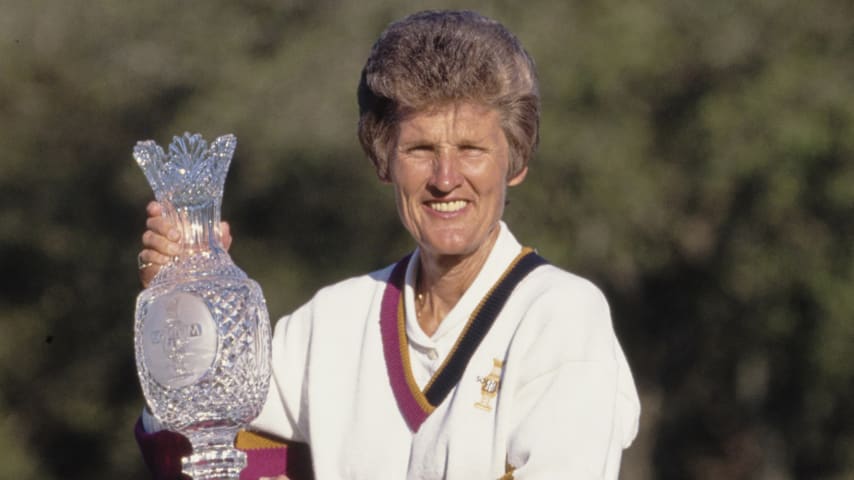Five things to know: Austin Country Club
8 Min Read
AUSTIN, TX - MARCH 28: Scenic view of the 13th green during the semifinal match at the World Golf Championships-Dell Technologies Match Play at Austin Country Club on March 28, 2021 in Austin, Texas. (Photo by Ben Jared/PGA TOUR via Getty Images)
Written by Kevin Robbins
Sixty-four players arrived this week for the World Golf Championships-Dell Technologies Match Play at Austin Country Club.
The club, founded in 1899, now occupies its third piece of property in Austin. Designed by Pete Dye, the newest course opened in 1984 along Lake Austin in the northwest corner of the capital city. The Dell Match Play, as it’s known around Austin, will be contested this week at ACC for the sixth time.
Often buffeted by feisty winds and featuring hilly inland holes with others exposed along the water, ACC includes the kinds of risks and rewards that make a golf course sumptuous for match play. Here are Five Things to Know about the history of the club — one of the oldest in Texas, by some accounts the oldest — and the personalities who have called it their golf home.
1. WHEN BEN MET TOM
Ben Crenshaw and Tom Kite shook hands for the first time on a Saturday afternoon in 1963 at ACC.
Crenshaw was 11 years old. Kite, whose family had just moved to Austin from Dallas, was 13. Seeing that Kite was playing as a single, young Ben invited young Tom to play with him, his brother and his father. Harvey Penick, the longtime head professional at ACC, came out to watch.
Kite wanted to make a good impression on the first hole. “I was the new kid on the block and trying to scratch my way in,” he recalled decades later.
So he settled into his address and took a mighty swing. The only thing that moved was the turf behind his tee.
“I had the prettiest, most beautiful divot,” Kite said, “laying right over the ball.”
He recovered well enough. With Crenshaw as his teammate, Kite helped the University of Texas golf team win two NCAA national championships. The two longtime friends and rivals tied for the individual medal in 1972. “Tying is like kissing your sister,” Kite told Crenshaw after the last round in Cape Coral, Florida.
“No,” Crenshaw replied. “It’s like kissing your brother.”
Both men went on to win 19 times on the PGA TOUR. Both were inducted into the World Golf Hall of Fame. They now spend their retirement in Austin, where Kite remains a regular fixture at the club. He passes a life-sized bronze statue on his way to the first tee. It’s of himself and Harvey Penick. Kite is in full follow-through as his coach looks on, a smile of satisfaction on his face.

2. A BOOK IS BORN
Bud Shrake, the famous novelist and sports journalist who lived in Austin, answered the telephone one morning in 1991.
The caller was Tinsley Penick, the head professional at Austin Country Club.
Penick asked Shrake to come to the club to meet with his father, Harvey. Harvey Penick had been long retired as the head pro at ACC, but he still gave occasional lessons there. In his late 80s at the time, Harvey had been taking notes for decades about his lessons at the club, from his careful study of the grip to the causes of a slice, every word hand-written with a shaky ballpoint pen. They were all there in a faded and worn Scribbletex notebook, red in color. Only his son had seen his father’s notes.
Until that day in ‘91.
Shrake arrived and found Harvey sitting in his golf cart by the practice tee, where he always was. Shrake noticed a briefcase in his lap.
“I want to show you something that nobody except Tinsley has ever read,” Harvey told Shrake. He snapped open the latch.
“Here.”
With that single word, Shrake and Penick would become a prolific and financially successful writing team, completing a total of four golf-instruction books, beginning with Harvey Penick’s Little Red Book, published in 1992. That first book became one of the best-selling sports titles of all time.
3. LPGA CONNECTION
In his celebrated tenure as the head pro at ACC from 1923 to 1971, Harvey Penick taught many accomplished men, most notably Crenshaw and Kite. He also had a hand in instructing some of the great female players of the 21st century.
Until the publication of the Little Red Book, which included many anecdotes involving Penick’s work with women, few people beyond the membership roster at ACC appreciated Penick’s role in shaping the modern LPGA.
The list of outstanding players who worked with Penick includes Betsy Cullen, Sandra Haynie, Mary Lena Faulk, Carol Mann, Betty Jameson, Judy Kimball, Betsy Rawls, Sandra Palmer, Kathy Whitworth, Peggy Wilson and Mickie Wright. Among them, they own hundreds of LPGA titles. Wright, who died in 2020, ranks second on the list of LPGA career wins with 82. Only Whitworth, with 88, has more.
Whitworth in particular blossomed under Penick. She learned as a young girl the foundations of the game from Hardy Loudermilk, a golf professional in her hometown of Jal, New Mexico. Duly impressed by her boundless potential, Loudermilk called Penick, who agreed to see her. Whitworth’s mother began toting her daughter from Jal, New Mexico to Austin in 1957, when Kathy was 17. It was a 450-mile round trip worth every minute on the road through the desert.
Whitworth won the New Mexico State Women’s Open in 1958. She repeated in 1959. She turned professional later that year.
“I still marvel at how all this started, how lucky that was,” Whitworth said in 2014. “When you look back on it, it’s like fate.”
Whitworth retired from competitive golf in 2005. She was named LPGA Player of the Year seven times — the same number of times she won the Vare Trophy for lowest scoring average in a season. Both she and Penick are members of the World Golf Hall of Fame.
“Harvey was to me,” she once wrote, “what Merlin was to King Arthur.”

Kathy Whitworth, Team Captain for the United States holds the trophy aloft after Team USA defeated Europe in the inaugural Solheim Cup competition golf tournament on 18th November 1990 at the Lake Nona Golf & Country Club in Orlando, Florida, United States. (Photo by David Cannon/Allsport/Getty Images)
4. HIGH LOW
Austin Country Club sits on 180 acres with two distinct forms. The front nine for the WGC-Dell Match Play unfolds on the high ground of the course, where cedars and oaks grow near exposed limestone revetments and native Texas scrub. The routing descends to Lake Austin at the par-5 12th hole, where the iconic Pennybacker Bridge comes into view from the tee.
The next three holes play on the treeless low ground of ACC, fully exposed to the springtime winds swirling in the valley. That’s as flat as the terrain gets in Austin, where the charming Texas Hill Country begins to the west. The course rises again toward the high ground on the 565-yard par-5 16th. The last two holes of the course represent a complete return to the highest points of elevation on the property.
The transition from high ground to low presents players with two exquisite risk-reward opportunities — the hallmark of a good match-play course.
Many players elect to try to reach the green in two at No. 12, a 578-yard hole called “Iron Bridge.” The hole tumbles directly downhill, and drives of 400 yards are possible if the ground is firm, leaving players a choice: go for the green or play short for a wedge in. The risk lurks all along the left side, where an inlet of Lake Austin hugs the fairway and the green.
Scottie Scheffler holes out from bunker for birdie at WGC-Dell Match Play
The par-4 13th, known as “Cape Dye,” spans 317 yards on the scorecard — but driving the green shortens the hole by up to 40 yards. Another inlet of Lake Austin laps at the left side of the fairway and half of the green. It’s an all-or-nothing carry to the flagstick.
And who can forget the feat Tiger Woods accomplished there in 2019?
Competing against Patrick Cantlay on the second day of group play, Woods played to the fairway. He swung his 60-degree wedge from 82 yards — and holed the shot.
His eagle there punctuated a furious comeback against Cantlay, who led 2-up after eight holes. Woods called the hole-out a “bonus.”
Bonus indeed. Woods won that match, 4 and 2.
Tiger Woods' 82-yard hole out for eagle at WGC-Dell Match Play
5. IN TRIBUTE
The life-sized bronze statue of Penick and Kite was unveiled on April 2, 1995. It was a bright and sunny Sunday at Austin Country Club.
Don Davis, a club member and accomplished sculptor, had cast the rendering in nearby Bastrop, Texas. A good crowd assembled for the unveiling ceremony. Penick was not among them. He was 90 years old, too weak and frail to attend. “He is with us in spirit,” his son Tinsley told the gathering.
Hours after the ceremony, Penick lay in his bed, covered in a floral purple comforter on Fawn Creek Path, less than a mile from the statue at ACC. He slipped away peacefully before sunset. A story on the front page of the Austin American-Statesman the next day noted that “Penick remained a hidden treasure until he gave author Bud Shrake the pages of a journal in a red notebook that he carried with him for 60 years.”
Three days later, on the morning of the memorial service for Penick, the grounds crew at ACC set out to cut the greens and place the flagsticks.
Passersby on Loop 360, the winding road that crosses the Pennybacker Bridge, could look down and notice an unusual sight on the greens on Lake Austin.
The flags on the greens hung at half-stick.